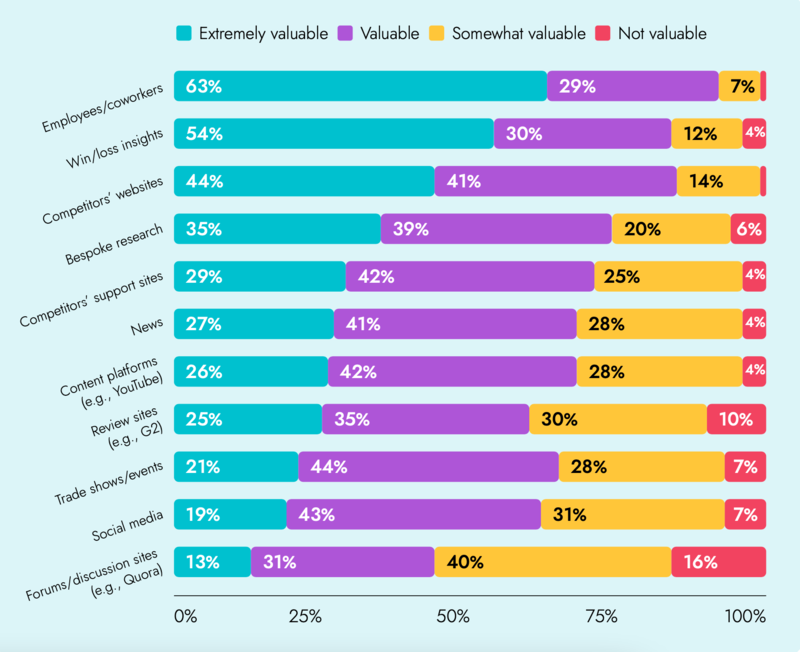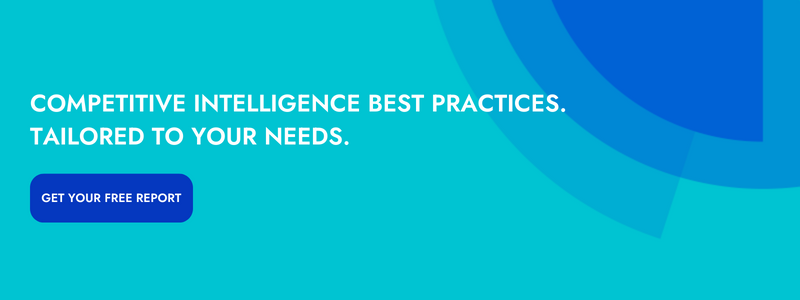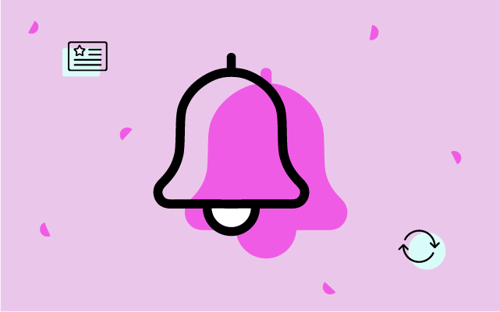Here at Crayon, we recently published the 2023 State of Competitive Intelligence, a benchmark report based on a survey of CI leaders and stakeholders.
We gave CI leaders a list of 11 sources of competitive intel and asked them to rate each one as either extremely valuable, valuable, somewhat valuable, or not valuable. Here is what we found:

63% of CI leaders say the intel they get from their coworkers—commonly known as "field intel"—is extremely valuable, making it the most valuable intel of all.
I can personally attest to this. Here's a quick story on how a well-run field intel program won my customer a huge opportunity.
This company (which I can’t name for obvious reasons) operates in a space where nearly every deal is competitive. Their sales team needs the most up-to-date competitive intel for every opportunity they open. One day, an account executive on the team (let's call her Cindy) struck gold on a prospect call. The prospect shared that their main competitor was going to come out with a new feature in Q1 2023—one that would play a large part in the prospect's evaluation of the two tools. This was frustrating news for Cindy, but with a stellar field intelligence program in place, the roadblock was avoided.
Cindy immediately shared this piece of information in their dedicated field intelligence Slack channel. From there, the word spread like wildfire. All the right stakeholders became involved to save the day, and this story had a happy ending. Cindy was soon contacted by someone on the product team who was able to share enough details about their similar (but better) feature release coming out before the competitor's. The deal was won, and that high level information on the feature launch was added to their battlecard for all to utilize if they encountered the same situation (which they did).
So, now that you know just how valuable field intelligence is, here are my 5 best tips for capturing it:
- Make it effortless for your colleagues
- Establish structure for submissions
- Create a tiger team
- Join sales & customer success team meetings
- Don’t be afraid to investigate
Let’s walk through each of these.
NEED COMPETITIVE INTELLIGENCE BEST PRACTICES? USE OUR FREE TOOL >>
1. Make it effortless for your colleagues
Wherever your colleagues like to spend their time, there should be an easy way for them to submit intelligence. Slack/Teams? Create a public channel. Email? Create an alias (e.g., intel@yourcompany.com). The key is that you cater to your colleagues’ habits and preferences. Not only does this promote the submission of intel, but it also creates rich repositories where you can easily access the latest submissions.
2. Establish structure for submissions
If field intel is a new concept for your organization, it’s important to set expectations. Give your stakeholders a template to ensure that they include all the necessary details. Here are a few key data points:
- Who the competitor is
- Description of the information gathered
- Any collateral, attachments, or links
- Where/who the information was gathered from
With a template, there won’t be any need to go back and forth on more details for clarification.
3. Create a tiger team
Teamwork makes the dream work right? Being the only person focused on competitive intelligence can cause unnecessary stress (especially because gathering information is not your only priority). With a team working together, you can segment days of the week for each person to keep an eye on the field intel channel and/or email alias.
The best candidates for your field intel tiger team are tenured sales and customer success reps who appreciate the value of your CI program. They interact with customers the most, which means they’re exposed to field intel the most!
4. Join sales & customer success team meetings
Like you, your stakeholders are busy. Typically though, sales and customer success have a standup meeting whether it be daily or a couple times a week. This is a golden opportunity to take 5 minutes of their time to ask about competitor intel they have received on calls.
Afraid of the awkward pause when no one has any? That doesn’t actually mean there isn’t any intel. Someone may just be too shy, or under the impression that their intel is unimportant. This is why it is crucial to commend the people that do provide field intel to support the culture around it.
5. Don’t be afraid to investigate
We certainly wish our stakeholders could remember everything they heard about a competitor, but sadly that is not realistic. That's why we have tools like Gong! If someone doesn’t remember the whole golden nugget of field intel, you can always go back and listen to the conversation it was mentioned in. I also recommend asking your Gong admin to set up trackers for each of your competitors, which will ensure that you’re notified whenever a customer mentions one of them.

Seeing is believing! Check out Crayon for yourself.
Take a Product TourRelated Blog Posts
Popular Posts
-
 The 8 Free Market Research Tools and Resources You Need to Know
The 8 Free Market Research Tools and Resources You Need to Know
-
 6 Competitive Advantage Examples From the Real World
6 Competitive Advantage Examples From the Real World
-
 How to Create a Competitive Matrix (Step-by-Step Guide With Examples + Free Templates)
How to Create a Competitive Matrix (Step-by-Step Guide With Examples + Free Templates)
-
 24 Questions to Consider for Your Next SWOT Analysis
24 Questions to Consider for Your Next SWOT Analysis
-
 How to Measure Product Launch Success: 12 KPIs You Should Be Tracking
How to Measure Product Launch Success: 12 KPIs You Should Be Tracking



